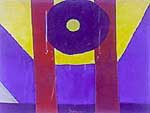
Culture, in America, has become a squeaky wheel looking for grease. Or so it often seems when the subject is an artist of subtle temperament. Arthur Dove (1880-1946), whose retrospective opened last week at the Whitney Museum of American Art, is a characteristic example: He is simply too quiet for contemporary taste. Typically grouped with the artists who gathered around the great photographer and impresario Alfred Stieglitz – among them Georgia O’Keeffe, Marsden Hartley, and John Marin – he is invariably presented as a pioneering American modernist. But he seems more mentioned than admired. Collectors rarely clamor for his work as they do for flashy O’Keeffes. His paintings, many of them muted in color, are not ingratiating. Even his name sounds gray, peaceful, dull, and oppressively worthy, like something you must learn for a class.
Yet Dove is an important figure in American culture – and not only because he was a pioneer. The current show, which was organized by the Phillips Collection in Washington and the Addison Gallery of American Art in Andover, Massachusetts, presents an artist more shaded in feeling than many of his American contemporaries. The curatorial team of Debra Bricker Balken, Elizabeth Hutton Turner, and William C. Agee concentrates mainly upon the oil paintings. (The landmark Dove exhibit of 1975, organized by the curator Barbara Haskell, included drawings and watercolors, some of which can now be seen at the Tibor de Nagy Gallery.) Influenced as a young artist by French Impressionism, Dove, who also worked in his twenties as a commercial illustrator, made one of the most astonishing leaps in American art – transforming himself in 1910 into a painter of near abstractions. From that point, he spent the rest of his life probing for the hidden pulse behind appearances. He was particularly attracted to thinkers who looked beneath the surface of the modern world – to Freud, for example, and to the French philosopher Henri Bergson. In Dove, even a stone wall seems to have a secret life.
Like his contemporaries in the Stieglitz circle, Dove was recoiling from the increasing materialism of his society. Inspired by the new European ideas about art – especially the vanguard’s drive toward an ever greater degree of abstraction – he hoped to renew the American sublime, creating a rhapsodic vision of the landscape that stood as a rebuke to smokestack America. He suffered for these views. His father, a manufacturer of bricks, cut him off because he chose to be an artist. For most of his life, he had to scrabble for money. Unable to support himself as a painter, he sometimes tried to eke out a living as a farmer in Connecticut and near his hometown of Geneva, New York. And more than most visionaries, he always retained the grounded sense of a farmer – which I admire, if only because too much high-flown feeling makes me think I’m being edged into a church.
Dove is a lyric poet, yet his work is filled with knotty tension. While the larger composition of one of his pictures may be bold, dramatic, and stark – with a line that moves swiftly across the surface – the actual paint may appear by contrast slow-moving and substantial; his brushwork is often strangely palpable, like growing grass. He does something similar in his treatment of the luminous. The light of revelation is never naked. It seems to emerge clothed in shade from some darkened place. (And may, one imagines, melt back into the shadows.) Dove is a crepuscular artist, an artist of the gloaming, with a melancholy feeling for somber tonalities. Because there is something intractable about nature that does not yield entirely to his desire, the harmonies in his painting do not appear too easily won. As a result, his pictures repay long looking in a way that the work of his contemporaries does not. Toward the end of his life, he grew less interested in this kind of tension, making images that are smoother and more purely abstract. Although these works anticipate Abstract Expressionism, they also give up some of the tang of nature. The curators have included a good selection of them.
Dove is often called provincial, because his use of the European idea of abstraction seems more borrowed than invented – more applied than deeply understood. Compared with Picasso, Matisse, or Mondrian, he is a brilliant tinkerer, amateur, and illustrator of moody sentiments. (Almost every painter is, compared with those guys.) Even so, the condescension directed at his work, which has its origins in the forties and fifties, is misplaced. Artists and critics in those years could not “see” an artist like Dove with any clarity because they were absorbed in another American modernism – Abstract Expressionism – that aspired to international stature. The earlier Americans were thought embarrassing in the best company. They were not wanted as “fathers.” Consequently, such critics could not recognize the beautiful vein of simplicity that once flowed through American culture and is now almost entirely lost – that plainsong (or plains song) you can find in the music of, say, Copland. Dove did what many of the best American artists and writers would do in the days when “culture” lay across an ocean and the public shunned serious art: He made any awkwardness seem like homespun honesty.